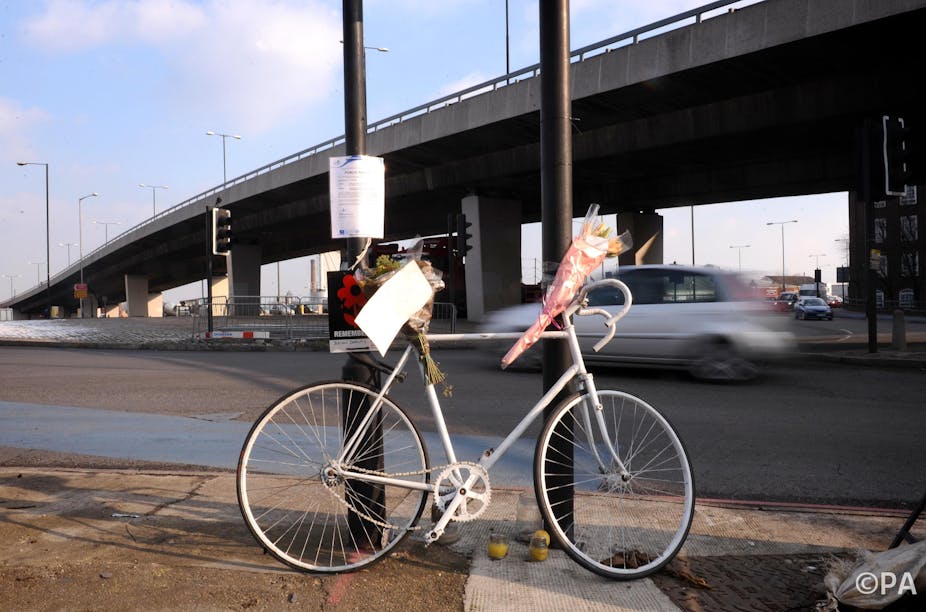It has been a grim month for cycling in London. Just days ago newspapers wrote of five deaths in nine days, and barely is the ink dry before yet another death this morning makes six in under two weeks. While shocking, the 14 cyclists killed in the capital this year follows a statistical trend – around 15 deaths, each year, over the last 20 years.
These figures could be interpreted various ways. Optimistically, one might argue that because the number of cyclists in London has grown, the number of deaths remaining static indicates a declining risk. This is perhaps thanks to safety in numbers; more cyclists on the road leads drivers to pay more attention, which results in greater cyclist safety. Indeed, Transport for London’s Cycling Safety Action Plan from 2010 echoed the argument made by Peter Jacobson years earlier that “policies that increase the numbers of people walking and bicycling appear to be an effective route to improving the safety of people walking and bicycling.”
However, road danger is not the only factor that affects the numbers of cyclists killed. In general, we expect deaths on the road to decrease (as has happened in Britain for many years) due to the continuously improving ability of accident and emergency services to keep seriously injured people alive.
In fact, taking the “safety in numbers” argument on its own, cyclists in London should have experienced a much greater reduction in risk, considering the large relative increases in the number of cyclists compared to other modes of transport. But that’s not what we see in the latest Transport for London figures that show deaths by mode of transport.
Injury figures show a worrying trend
While the spotlight is trained on cycling in London – with a fairly good base of research data and relatively strong political pressure – it’s far from exceptional. At a national level, DfT refer to “a well-established upward trend in pedal cyclist casualties”.
Between 2005-09 an average of 420 cyclists were seriously injured each year in London. In 2011 the figure rose to 571, and rose again in 2012 to 671 – these are statistically significant increases, unlike the trend in cycle deaths. Slight injuries to cyclists have increased by nearly 50% on the 2005-09 figures. These injuries should be a wake-up call.
In Copenhagen from the late 1990s onward, cycling levels have increased while the absolute numbers of deaths and injuries declined. This is not a virtuous circle that Britain seems to have found a way into; instead cycle deaths refuse to fall and injuries are rising.
The avoidable death toll is substantial. If we compare similar age groups (to give a more accurate picture of risk than overall figures) we see most deaths would not have happened if our roads were as safe as Dutch roads are for cyclists. A cyclist in his or her 30s in England faces seven times the risk per kilometre than a similar cyclist in the Netherlands.
The answers are already known
What to do? As the London Cycling Campaign has been arguing, we need to learn from the best and “go Dutch”. We need to create forgiving environments where mistakes – whoever makes them – do not routinely kill the vulnerable. This means separating high-volume, high-speed, and heavy-goods vehicle motor traffic away from cyclists.
This can take many forms – a peak-hour HGV ban has been mooted in London recently, at least until better infrastructure is built. HGVs account for around half of all London cycle deaths, even though they comprise a tiny proportion of London’s traffic. Other urgent priorities are laying down high-quality, protected cycle infrastructure on main roads, and drawing through motor traffic away from residential streets.
At present, we have a public health emergency on our roads because we fail to prioritise people’s safety over the flow of traffic. In 2008, the University of the West of England responded to a transport consultation, arguing that it was dominated by “excessive attention to the achievement of a large number of very small time savings for vehicle traffic”. In other words, shaving seconds off thousands of car journeys has been prioritised above people’s safety.
This is still built into scheme design, such as at the notorious Bow Roundabout (two deaths in two weeks) and many other places where people die unnecessarily. LCC reported that Ben Plowden of TfL told the inquest into Brian Dorling’s death at Bow that safer solutions for pedestrians and cyclists recommended by experts had been blocked by the prediction of “motor traffic tailbacks and congestion”.
Sheffield geographer Daniel Dorling (no relation) describes Britain’s roads as “the open sewers of the 21st century”. Soon, I hope, we will look back in horror at the times when it was acceptable to put motor traffic flow ahead of people’s lives.

